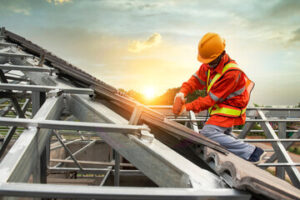The roof is one of the most important aspects of any home. The material, style and installation methods all have a significant impact on the longevity of the structure and the overall appearance of the house.

There are many roofing options available today. From traditional asphalt shingles to newer metal and real slate roofs. Contact EZ Roofing of Flagler County for professional help.
Whether you’re building a new home or need to replace your current roof, it’s important to choose the right roofing materials. Not only will you want to consider your budget, but also how the various types of materials stand up to different weather conditions. This will affect the longevity of your roof and how well it protects your home.
Shingles are a popular option that are available in a variety of materials. They are easy to install, affordable and offer good protection against the elements. However, they don’t last as long as other roofing materials and can be susceptible to moss and mildew if not regularly maintained.
Wood shingles and shakes are another natural option that offers a rustic look. They are made from a variety of woods such as pine, cypress, and red cedar and come in a range of thicknesses. Wood shingles are thin slabs of sawn wood, while shakes are thicker wedges with a rough texture. They are durable and resistant to rot, insects, and fire but are not suitable for areas that experience wildfires.
Tile roofing is another durable option that’s available in a wide variety of colors and styles. It is a popular choice in hot climates as it doesn’t absorb heat and can be very durable. However, clay tiles can be fragile in extremely cold temperatures and may need additional support from the structure.
Membrane roofing is a newer type of roofing that’s becoming increasingly popular. It consists of large sheets that are fused together in some way to form a single surface. Membrane roofing is lightweight and can be installed on flat or low-sloped roofs. It can also be installed over existing roofing materials.
Roof decking is the structural foundation of your roof. It can be made from plywood, OSB, LVL, or planks of lumber. It is often covered with a layer of underlayment that helps to prevent water penetration and seals the joints between boards. The underlayment is typically a waterproof membrane such as rubber, PVC, or TPO. It can be attached to the decking with fasteners or glued down using adhesives.
Design
Roofing design is an important part of the overall building structure. It determines how water will shed off the roof and into drains or downspouts. The slope or pitch of the roof is also an important design feature, as it determines how much a roof rises for each foot of horizontal distance. This information helps in the planning of drainage and other structural features of a roof. Fire resistance is another important design consideration in roofing. Classes A through C fire ratings indicate a roofing material’s ability to withstand different levels of exposure to fire.
Installation
A roof is the primary defense for a building, and a good quality one can protect the space below from water and other weather conditions. Installing roofing is a complex process that requires several different pieces of equipment to get the job done right. It’s important for the contractor to take proper safety precautions, including the use of a ladder that can support the weight of a person working on it and appropriate fall protection.
It is also important to waterproof areas where the roof slopes form a “V” shape, such as valleys. This is usually done using underlayment and felt paper, with each valley’s specific structure in mind.
Many resources are available to assist with the implementation of fall prevention and control measures in the construction industry, including a construction fatality database,[23] a ladder safety mobile application,[24] infographics and tipsheets,[25] toolbox talks and videos, and more. The preferred preventive actions are those in the hierarchy of controls – elimination, substitution, and engineering controls, with elimination being the most effective.
Maintenance
A roof’s primary function is to protect a home from harsh weather elements, and it’s important for homeowners to engage in regular roofing maintenance to extend its lifespan. BM Roofing offers residential roof maintenance services that can keep homes safe and dry during fall and beyond.
A thorough inspection of a roof should be done on an annual basis to look for any problems that may arise. This includes checking shingles for signs of excessive wear and tear or any that are missing completely. It is also a good idea to inspect flashing, which is a strip of metal installed to seal areas where the roof meets other surfaces like chimneys or skylights. Check for cracks or rusting, and make sure that any gaps are sealed with caulk.
Inspecting penetrations like vent pipes, exhaust fans, and chimneys is also a must, since these can cause leaks if not properly sealed or insulated. It’s also a good idea to remove any moss or lichen that may have formed on the surface of a roof, as these organisms can trap moisture against the shingles and shorten their lifespan.
It is also a good idea to trim tree branches that hang over a roof on an annual basis. This can help to reduce the risk of damage during stormy weather, when limbs can break off and fall onto the roof. Ideally, there should be a minimum of 10 feet between the edge of a roof and any branches that are close enough to touch it. This will prevent branches from scraping against the shingles during storms, and it will reduce the likelihood that animals or debris will access the roof through these areas.
